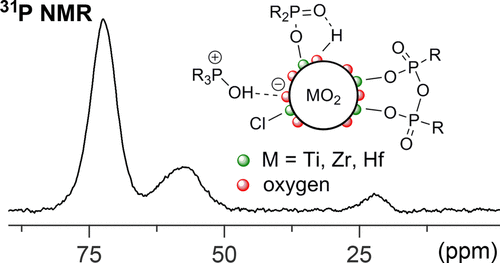当前位置:
X-MOL 学术
›
Chem. Mater.
›
论文详情
Our official English website, www.x-mol.net, welcomes your feedback! (Note: you will need to create a separate account there.)
Stabilization of Colloidal Ti, Zr, and Hf Oxide Nanocrystals by Protonated Tri-n-octylphosphine Oxide (TOPO) and Its Decomposition Products
Chemistry of Materials ( IF 8.6 ) Pub Date : 2017-11-17 00:00:00 , DOI: 10.1021/acs.chemmater.7b04580 Katrien De Keukeleere 1 , Sofie Coucke 1 , Els De Canck 1 , Pascal Van Der Voort 1 , Fabien Delpech 2 , Yannick Coppel 3 , Zeger Hens 1 , Isabel Van Driessche 1 , Jonathan S. Owen 4 , Jonathan De Roo 1, 4
Chemistry of Materials ( IF 8.6 ) Pub Date : 2017-11-17 00:00:00 , DOI: 10.1021/acs.chemmater.7b04580 Katrien De Keukeleere 1 , Sofie Coucke 1 , Els De Canck 1 , Pascal Van Der Voort 1 , Fabien Delpech 2 , Yannick Coppel 3 , Zeger Hens 1 , Isabel Van Driessche 1 , Jonathan S. Owen 4 , Jonathan De Roo 1, 4
Affiliation

|
Although TiO2, ZrO2, and HfO2 nanocrystals are often synthesized in tri-n-octylphosphine oxide (TOPO), it is unclear whether TOPO also serves as ligand. Using liquid and solid state 1H and 31P nuclear magnetic resonance spectroscopy and X-ray fluorescence spectroscopy, we show that the nanocrystal surface is capped by several derivatives of TOPO. In the 31P NMR spectrum, di-n-octylphosphinate (δ = 57 ppm) and P,P′-(di-n-octyl) pyrophosphonate (δ = 20 ppm) are found coordinated to the nanocrystal. In addition, hydrogen chloride associates with the metal oxide nanocrystal surface and protonates TOPO. The resulting hydroxyl-tri-n-octylphosphonium, [HO-PR3]+, is tightly associated with the nanocrystal surface (δ(31P) = 73 ppm) due to electrostatic interactions and hydrogen bonding. To simplify the complex surface composition, we exchange the original surface species for carboxylate or phosphonate ligands. The protonation of TOPO is an unexpected example of lyophilic ion pairing between an acidic metal oxide nanocrystal and a weakly basic ligand molecule that is formed in nonpolar solution. Our results contrast with the classically envisaged L-type binding motif of TOPO to surface metal ions. The generality of this stabilization mode and its relevance to catalysis is discussed.
中文翻译:

胶体钛,锆,铪和氧化纳米晶的稳定质子化磷酸三ñ -octylphosphine氧化物(TOPO)及其分解产物
虽然二氧化钛2,的ZrO 2和HfO 2层的纳米晶体在三经常合成Ñ -octylphosphine氧化膦(TOPO),目前还不清楚是否TOPO也用作配位体。使用液态和固态1 H和31 P核磁共振波谱和X射线荧光光谱,我们显示纳米晶体表面被TOPO的几种衍生物覆盖。在31 P NMR光谱中,正辛基次膦酸二正丁酯(δ= 57 ppm)和P,P ′-(di- n发现焦磷酸正辛酯(δ= 20 ppm)与纳米晶体配位。另外,氯化氢与金属氧化物纳米晶体表面缔合并质子化TOPO。将得到的羟基的三Ñ -octylphosphonium,[HO-PR 3 ] +,紧密地与纳米晶体表面(δ相关联(31由于静电相互作用和氢键,P)= 73 ppm)。为了简化复杂的表面组成,我们将原始的表面物种交换为羧酸盐或膦酸盐配体。TOPO的质子化是酸性金属氧化物纳米晶体与在非极性溶液中形成的弱碱性配体分子之间亲液离子配对的出乎意料的例子。我们的结果与经典设想的TOPO与表面金属离子的L型结合基序形成对比。讨论了这种稳定模式的一般性及其与催化的关系。
更新日期:2017-11-17
中文翻译:

胶体钛,锆,铪和氧化纳米晶的稳定质子化磷酸三ñ -octylphosphine氧化物(TOPO)及其分解产物
虽然二氧化钛2,的ZrO 2和HfO 2层的纳米晶体在三经常合成Ñ -octylphosphine氧化膦(TOPO),目前还不清楚是否TOPO也用作配位体。使用液态和固态1 H和31 P核磁共振波谱和X射线荧光光谱,我们显示纳米晶体表面被TOPO的几种衍生物覆盖。在31 P NMR光谱中,正辛基次膦酸二正丁酯(δ= 57 ppm)和P,P ′-(di- n发现焦磷酸正辛酯(δ= 20 ppm)与纳米晶体配位。另外,氯化氢与金属氧化物纳米晶体表面缔合并质子化TOPO。将得到的羟基的三Ñ -octylphosphonium,[HO-PR 3 ] +,紧密地与纳米晶体表面(δ相关联(31由于静电相互作用和氢键,P)= 73 ppm)。为了简化复杂的表面组成,我们将原始的表面物种交换为羧酸盐或膦酸盐配体。TOPO的质子化是酸性金属氧化物纳米晶体与在非极性溶液中形成的弱碱性配体分子之间亲液离子配对的出乎意料的例子。我们的结果与经典设想的TOPO与表面金属离子的L型结合基序形成对比。讨论了这种稳定模式的一般性及其与催化的关系。


























 京公网安备 11010802027423号
京公网安备 11010802027423号